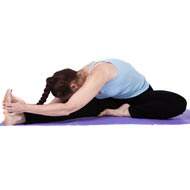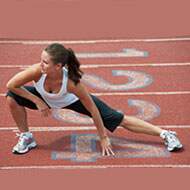Head To Knee Pose
Head to Knee Pose
The Head to Knee Pose, also known as “The Seated Forward Bend” or Paschimottanasana, is one of the 12 basic postures in Hatha Yoga.
The Sanskrit name is derived from the words paschim which means west (as in west side or the back of the body), uttan which means stretch and asana which means posture.
This pose has many benefits, the most obvious one being to stretch the entire back, from the top of the head all the way down to the heels. Apart from this, there are numerous other benefits which we shall take a look at later in the article.
Steps
These are the steps for the Head to Knee pose.
- Place a yoga mat or a blanket on the floor.
- Sit on the yoga mat or blanket with your legs straight out in front of you.
- Your feet should be together, pointed straight up towards the ceiling.
- Your back should be straight.
- Move the flesh from under your buttock to the side so that you are sitting directly on your sitting bone. This will ensure that your spine is straight.
- Stretch your arm up over your head and take a deep breath at the same time. As your arms rise up, stretch your entire spine upwards.
- Slowly bend forward from the hips while exhaling at the same time. Keep your spine as stretched as possible and as your hands descend, reach towards your feet.Do not bend your knees.
- Ideally, if you can reach your feet, your index fingers should be wrapped around your big toes and your thumbs should rest on top of them.
- If you are unable to reach your feet, let your hands come to rest on your shins or thighs. You may also let them rest alongside your legs if that is more comfortable.
- Try to keep your spine as straight as possible while bending forward from the hip.
- Make sure that your feet remain together and pointed up at the ceiling.
- Once you have attained the position, you can gently pull with your arms so as to bring your head closer to your feet and stretch your spine and the back of your legs some more.
- Hold the pose for 30 seconds initially, gradually working up to 5 minutes.
- As you hold the pose, try to relax your shoulders and hips.
- Continue to breathe as you hold the pose.
- As you breathe, your abdomen should fall close to your thighs, your chest towards the knees and your head towards your feet.
- When you are ready to exit this pose, inhale and stretch your hands beyond your feet. Then slowly raise your torso, stretching your arms and spine as you come up. Make sure you keep your back straight while coming back up. Exhale and bring your arms down and relax.
Precautions
Avoid this pose if you have:
- Asthma
- Diarrhea
- Any form of back injury
- Had recent abdominal surgery
Other precautions for Head to Knee pose include:
- Initially, you may not be able to bend completely and touch your head to your feet or legs. Do not force yourself to stretch that much further. Only go as far as you’re comfortable.
Beginner’s Tips
Here are some beginner’s tips for The Head to Knee pose.
Try sitting on a cushion or a block. This will help to elevate your pelvis, enabling you to bend from your underwear line rather than your waistband.
Another thing that will help you is sitting on the floor. Getting into the habit of sitting on the floor will help to loosen up the hip muscles which remain tight because we are so used to sitting on chairs.
Benefit to the body
Paschimottanasana can help the body in many ways. Benefits to the body include:
- It stretches the muscles of the back from head to toe
- It contracts the muscles on the anterior part of the body
- It improves flexibility of the spine, hips and thighs.
- Pressure exerted on the thorax and abdomen help to improve respiration and functioning of the abdominal glands.
- It massages and tones all the organs in the abdominal and pelvic regions including the liver, pancreas, kidneys, spleen and intestines, thereby improving their functioning.
- It improves blood circulation in the spinal region and helps to tone the nerves of the spine.
- It helps to improve the alignment of the vertebral column.
- It helps to burn off fat deposits from the abdomen, hip and thighs.
- It helps to activate the kundalini energy.
- Mentally, it helps to calm the mind, removing negative emotions such as anger, irritability and anxiety.
Benefits for Women include:
- It helps to balance the menstrual cycle by stimulating blood flow to the pelvic region.
- It helps to remove congestion from the pelvic region.
- It helps to relieve pain and menstrual cramps.
- It acts as a mood stabilizer, helping to calm emotions.
Therapeutic Applications
Therapeutic applications of Paschimottanasana include:
- Diabetes
- Bronchitis
- Liver disorders
- Colitis
- Kidney disorders
- Menstrual disorders
Variations
Variations for Head to Knee pose include Urdhva Mukha Paschimottanasana. The Sanskrit name is derived from the words urdhva meaning upward and mukha meaning face. This is the upside down version of Paschimottanasana. This is how it is done.
- Lie flat on your back.
- Exhale and bend your knees into your torso.
- Slowly inhale and extend your heels towards the ceiling.
- Slowly exhale and swing your legs back over your head so that your feet reach the floor.
- Do not let your pelvis lift off very far off the floor.
- Initially you may not be able to get your feet to touch the floor. If you cannot, then bring your legs as far back as possible.
- Hold the pose for 30 seconds and gradually work up to 5 minutes.
Preparatory Poses
Preparatory poses for Head to Knee pose include:
- Ardha Paschimottanasan
- Vajrasan Yoga Mudra Type 1 and 2
- Standing Forward Bend
Preparatory Movements for Paschimottanasana include:
- While sitting, spread your legs apart and stretch your arms out. Clasp your hands together and perform a grinding action by rotating your body. Do this five times in each direction.
- While sitting, spread your legs apart and bend forward. Touch your right foot with your left hand while looking over the right shoulder. Do this five times for each side.
Follow Up Poses
Follow up poses include:
- Ardha Matsyendrasana



